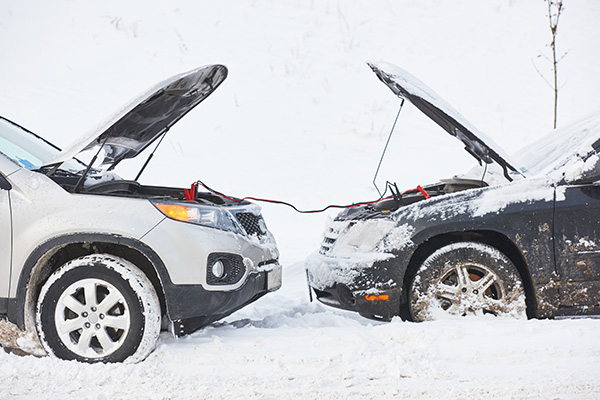
Cold weather can be tough on your vehicle’s battery. If your car has ever struggled to start on a chilly morning, you’ve seen firsthand how dropping temperatures affect performance. Fall is the perfect time to get ahead of potential problems before winter hits. A weak battery might still crank your engine during warmer months, but once the temperature drops, that same battery could leave you stranded.
Here’s how to prepare your battery for cold weather and avoid surprises when you need your car the most.
Why Batteries Struggle in Cold Weather
Car batteries rely on a chemical reaction to generate electricity. When the temperature falls, that reaction slows down, reducing the battery’s ability to produce power. At 32°F, a battery loses about 20% of its strength. By the time it hits 0°F, it can lose more than half. Meanwhile, your engine oil thickens, and electrical demands increase with things like the heater, defroster, and headlights all in use.
That’s a tough combination for an aging or undercharged battery. If the charge is already low, cold weather may be enough to keep your engine from starting.
1. Test Your Battery’s State of Charge
One of the most important steps is having the battery tested. A technician can check the voltage, cranking amps, and reserve capacity. These numbers indicate the remaining battery life and its performance in cold conditions.
A fully charged battery should measure around 12.6 volts or higher. If it’s lower, your car may still start, but that battery is working harder than it should and may not last the season.
2. Look for Signs of Corrosion or Loose Connections
Cold weather puts extra stress on every part of the starting system, and even minor issues can escalate into major problems. Corrosion around the terminals can block electrical flow, which makes it harder for your vehicle to start.
Look for a white or bluish powder near the battery posts. If you see buildup, clean it carefully using a mix of baking soda and water. Make sure the cables are tightly connected to the terminals. Loose or dirty connections can lead to poor charging and reduced cranking power.
3. Check the Age of Your Battery
Most car batteries last about three to five years. If yours is getting close to the end of that range, now is a good time to consider replacing it. Even if it has worked fine during the summer, winter will be much more demanding. Don’t wait for it to fail on a freezing morning before work.
If you’re unsure about the battery’s age, check the label on top or the side. Most batteries are marked with a date code that tells you when it was manufactured.
4. Inspect the Alternator and Charging System
The alternator charges your battery while the engine is running. If it isn’t working properly, your battery might not be getting the power it needs. Signs of a failing alternator include dim headlights, battery warning lights on the dashboard, or electrical accessories not working as they should.
Testing the alternator is quick and can be done during a routine battery check. If the alternator is weak, replacing the battery alone won’t solve the problem.
5. Keep the Battery Clean and Secure
Dirt and grime on the battery can act as a conductor and slowly drain power over time. Regularly wipe down the top of the battery with a dry cloth. Also, make sure the battery is properly secured in its tray. Vibration from a loose battery can cause internal damage, shortening its lifespan.
It’s also smart to check the battery case for cracks or bulges. Extreme temperatures can cause the casing to swell, especially if it’s already weakened from age or poor charging conditions.
6. Don’t Let Short Trips Drain the Battery
Cold starts require more energy, and if your daily drive is only a few minutes, your battery might not have enough time to fully recharge. Over time, this can lead to a gradual loss of power.
Try combining errands into one longer trip to give the battery time to recharge fully. Or, consider using a battery maintainer if the vehicle is parked for extended periods.
7. Consider a Battery Blanket or Insulator
If you live in an area where winter temperatures regularly dip below freezing, a battery blanket can help. These warming pads wrap around the battery and plug into a standard outlet. They help maintain the battery’s temperature overnight, making it easier to start the car in the morning.
Some vehicles also use insulating covers that protect the battery from extreme temperature swings. Ask your technician if this is something your car can benefit from.
Bonus Tip: Keep Jumper Cables or a Jump Pack Handy
Even with all the right maintenance, cold weather can be unpredictable. Having a jump starter in your trunk or a good set of jumper cables can save you from being stranded. These tools are especially helpful if you drive in rural areas or park outside overnight.
Schedule Your Battery Service at Jeff's Automotive, Inc in Easton, PA
If your battery is more than a few years old or showing signs of weakness, don’t wait for winter to test it. At Jeff’s Automotive, Inc in Easton, PA, our technicians can test your battery, inspect your charging system, and recommend any services to keep your vehicle starting strong all season long. Let us help you stay one step ahead of the cold.
Schedule a battery inspection today.